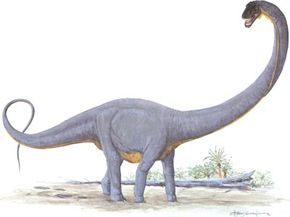SUPERSAURUS (SUE-per-SORE-us)
Period: Late Jurassic
Advertisement
Order, Suborder, Family: Saurischia, Sauropodomorpha, Diplodocidae
Location: North America (United States)
Length: 100 feet (30 meters)
Supersaurus deserves its name, "super reptile." A relative of Apatosaurus and Diplodocus, this enormous plant-eater was rare in the Late Jurassic. Supersaurus is known from a single shoulder bone (the scapulacoracoid), which is nearly eight feet long. Only the scapulacoracoid of Ultrasaurus is as long or longer.
Other bones from the same site, the Dry Mesa Quarry in southern Colorado, have also been identified as Supersaurus. These include a separated ischium (one of the bones of the pelvis), a complete sacrum and pelvis, a separate tail vertebra, and a section of 12 articulated (joined) tail vertebrae.
If restorations of Supersaurus are correct, this sauropod was at least 100 feet in length and stood more than 18 feet tall at the shoulder. Stretching the neck up into the trees for soft young shoots, Supersaurus could reach 50 feet above the ground, or about the height of fifth story windows. Brachiosaurus could reach around 40 feet above the ground. The size of Supersaurus is difficult to estimate because only the two scapulacoracoids definitely belong to this genus; the other bones are not positively from Supersaurus so they cannot be used to figure sizes.
The long shoulder bones of Supersaurus are surprising, because other members of the family Diplodocidae have short front legs and long rear legs, unlike the giraffe dinosaurs of the family Brachiosauridae where long scapulacoracoids and long front legs are typical. By comparing proportions of the scapulacoracoid of Supersaurus with those of other members in the family Diplodocidae (such as Diplodocus or Apatosaurus), scientists have concluded that this giant sauropod was a record-breaker for length and mass. Only "Seismosaurus" may have been longer.
Supersaurus, like other giant sauropods of the Late Jurassic, was so large that even the largest predatory dinosaur, Allosaurus, was little threat. But the carnivores were always ready to attack weak or sick animals, or to separate young sauropods from their herds.
The feeding habits of Supersaurus were probably like those of other sauropods. They ate leaves and shoots from treetops and ferns from the ground, and they fed almost constantly. Adults must have eaten hundreds of pounds each day. Gastroliths (or "stomach stones") may have helped grind the plants and leaves in the stomach.
Supersaurus is a puzzle that can only be solved by more excavations at the Dry Mesa Quarry. More than a dozen dinosaurs are known from the quarry, each having several hundred bones per animal. With such a mix-up of bones, many years of excavation and careful study will be necessary to resolve the identity of this colossal dinosaur.
Advertisement
